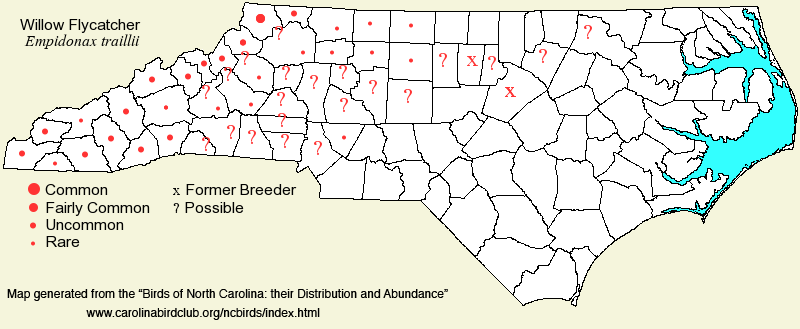 |  |
|
Willow Flycatcher - Empidonax traillii TYRANNIDAE Members: | Search Common: Search Scientific: |
|
|
|||||||
| General Comments | In 1973, the American Ornithologists' Union split Traill's Flycatcher into two "song type" species -- the "fee-bee-o" Alder Flycatcher and the "fitz-bew" Willow Flycather. The Willow is the more "southern" of the two, though the breeding ranges overlap considerably, and it does not nest in most of the southern half of the United States. It nests throughout the lower elevations of the NC mountains, overlapping in elevation only slightly with the Alder Flycatcher. It also breeds sparingly into the Piedmont, at very localized sites. Otherwise, it is a poorly known migrant through the state, owing to difficulty of sight identification with other Empidonax flycatchers. And, even if heard giving its call ("whit"), the call is very similar to that of the Least Flycatcher; thus, reporting of migrants must be done with care. Willows breed in open country, mainly in wide valleys with streamside thickets and corridors of trees adjacent to fields; marshes with shrubs and small trees are also utilized. Interestingly, this species was not known to nest in NC prior to the late 1950's, when a breeding pair was found nesting near North Wilkesboro. | ||||||
| Breeding Status | Breeder | ||||||
| NC BRC List | Definitive | ||||||
| State Status | W | ||||||
| U.S. Status | |||||||
| State Rank | S3B | ||||||
| Global Rank | G5 | ||||||
| Coastal Plain | Transient. Poorly known because of difficulty of identification. Very rare to rare (probably) along the coast in both spring and fall, but apparently only four inland records -- Weldon, Fayetteville, Fort Bragg, and River Road in Cumberland. Records are in late May and early Jun, and from early Sep to early Oct, rarely to late Oct. One seemingly on territory in central Carteret from 18 Jun - 9 Jul 2006 was quite unusual. The extreme scarcity of records from the province except for the coast is shocking, suggesting that the primary migration route (as with the Alder Flycatcher) is farther to the west -- through the Piedmont and mountains. Peak count: 3, Pine Island Audubon Sanctuary (Currituck), 29 May 1986. | ||||||
| Piedmont | Transient, and sparse summer resident. Rare and local breeder in scattered sites in the western half of the region, currently and consistently east to Guilford and Cabarrus; recent isolated summer records farther east to Durham, Wake, Franklin, and Halifax; formerly nested east to Orange and Wake. Otherwise, a seemingly rare (to possibly uncommon) migrant -- poorly known because of identification difficulties. Mainly early May to about mid-Sep, but departure dates are poorly known. Peak counts: 10, Winston-Salem, May - Jun 1990; 4, near Raleigh, May - Jun 1972. | ||||||
| Mountains | Summer resident. Uncommon, to very locally fairly common, at lower elevations throughout the region; mostly below 3,000 feet, but sparingly to about 3,500 feet elevation. Probably most numerous along the New River and its forks in Ashe and Alleghany. Mainly mid-May to late Sep; a late arriving species on its breeding grounds, essentially after 10 May, though with global warming the arrival dates are moving to early May or late April by 2021. Peak counts: 19, spring bird count in Henderson, 12 May 2001; 12, Newland area, 14 Jun 1987. | ||||||
| Finding Tips |
Good places to look for the species are to drive along roads that parallel the New River, or the South Fork New River; roads that cross creeks in the Mills River valley in northern Henderson; or roads that cross creeks in the French Broad River valley, in central Transylvania. *** | ||||||
| Attribution | LeGrand[2025-02-03], LeGrand[2023-03-24], LeGrand[2021-09-04] | ||||||
| NC Map Map depicts all counties with a report (transient or resident) for the species. | Click on county for list of all known species. |
| NC Breeding Season Map Map depicts assumed breeding season abundance for the species. |  |